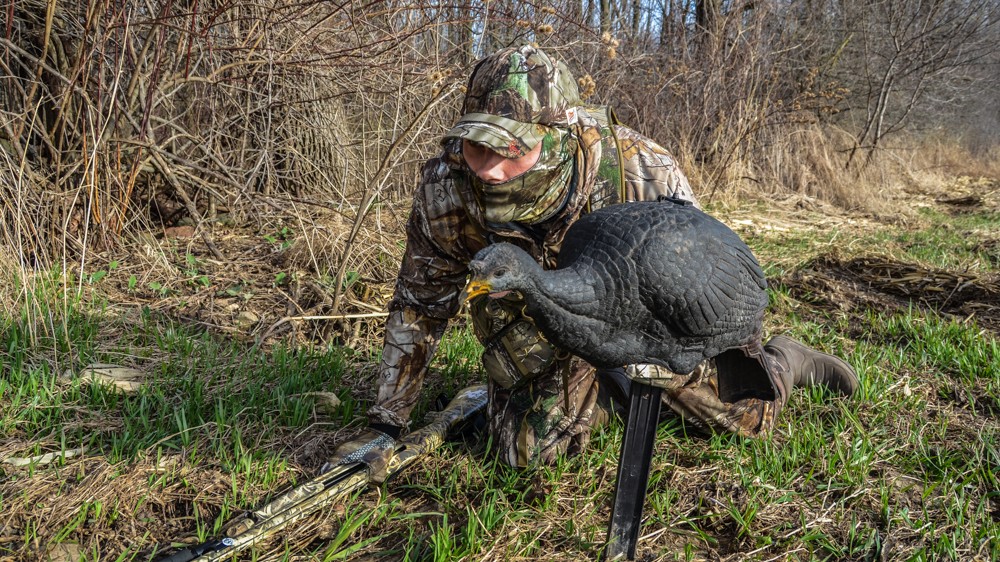One of the properties I used to turkey hunt was nothing but 100 acres of mixed ag fields with one shallow drainage ditch and tree-lined perimeter (pictured below). Despite the lack of habitat diversity, there was always at least one turkey in the field somewhere and, more often than not, a whole group of birds. It was a terrific turkey hunting property, but it lacked one thing: cover. No, not cover for the birds, but rather, for us. It was absolutely impossible to sneak anywhere. We were pretty much stuck in our starting location for the morning, unless we wanted to risk busting the field, relocating, and then waiting out their return. While it was fun to watch the toms strutting all morning long, it was also frustrating.
 Here’s an aerial view of the property I was referring to. Turkeys would be in the field somewhere, but it was extremely difficult to ever make a move on them due to the lack of cover and flatland topography.
Here’s an aerial view of the property I was referring to. Turkeys would be in the field somewhere, but it was extremely difficult to ever make a move on them due to the lack of cover and flatland topography.
Here are a few tips I’ve learned over the years from some of the best turkey hunters in the business. Hopefully they’ll help you outsmart those witty field gobblers this season.
Use the Cover of Darkness
Get in early and get in close. Using the cover of darkness, sneak in close to the roosted birds well before you hear the first gobble. This works best if you roost the birds the night before so you know exactly where to set up. If possible, get yourself situated between the tom and the hens. If you can’t get yourself positioned between the hens and the gobbler, you’ll want to be in their fly down zone. If the tom gets to the hens before you have the chance to work him in, it can be a tough morning of hunting.
A full-strut gobbler decoy along with single hen decoy in breeding pose work well in this situation. The tom will think there is an intruder trying to steal his hens and come running to the spread. As far as calling goes, you’ll want to remain silent up until he’s about ready to pitch down off the limb. Then give a few soft yelps to let him know there’s some hens over there. A lot of times the decoys will do the work in this situation and you won’t have to do much calling.
 A full strut decoy paired with a breeding hen is my go-to setup for much of the early season, as toms are still sorting out dominance.
A full strut decoy paired with a breeding hen is my go-to setup for much of the early season, as toms are still sorting out dominance.
Mid-day Sneak Attack
Spot, think, and then move. It’s not uncommon to spot a strutter out in a field during the middle of the day. In fact, this how many of my run-and-gun turkey hunts begin. Things can get slow once the morning gobble turns off and the only way to know if there are any birds in the area is if you see them. Hunting in farm country often lends itself to spotting birds from afar and allows you to come up with a game plan to get in close. The only problem with this scenario is that the toms usually aren’t alone.
Use the topography and cover to get in as close as possible. It’ll be tough to call a gobbler off a hen without any visual representation. The best case scenario would be to get a full strut decoy setup on the crest of a hill where he can see it and you can set it up without getting busted. This takes patience and willingness to belly crawl your way back to cover. If you can’t get a decoy set out, try to position yourself close to where the group may be heading and wait for a passerby. It gets really tough if you’re hunting flat open country like the farm I originally talked about. Here it’s best to keep your distance and hope that you can draw him in with the site of another (fake) gobbler. If not, you might be able to use the next exciting tactic.
Turkey Fanning
Turkey fanning or reaping is an intense hunting tactic that requires you to literally tango with the turkeys. If you’re not familiar, there’s some crazy youtube videos out there and I also talk about it more in this article. Basically, you hide behind an open tail fan while approaching a gobbler. Once he sees the intruding tom (you), he’ll do one of two things depending on his age and dominance – charge or run off, the first option seems to be more common. Wait until he gets close, then drop the fan, shoulder your gun, and fire the shot. It’s intense and effective, but should be used with extreme caution and on private lands only.
Hunting turkeys over large fields is a pretty common situation for many hunters across the country, but it can also prove to be difficult. It’s just like bow hunting for deer over a large ag field – you often see them, but you rarely get a shot. The same holds true for turkeys – you often see them strutting, but it’s tough to draw them within range, especially if they are with hens. Decoys and landscape are the most important tools to help you get close. Use them correctly and you may just leave the field with a longbeard slung over your shoulder.







